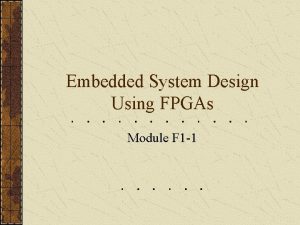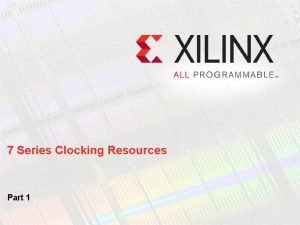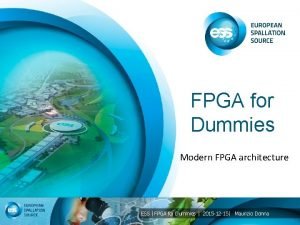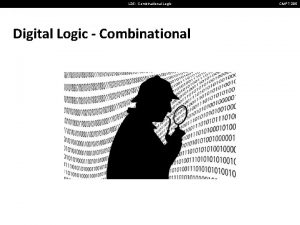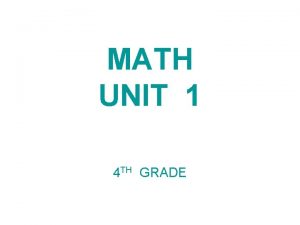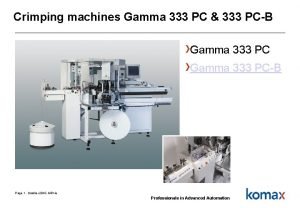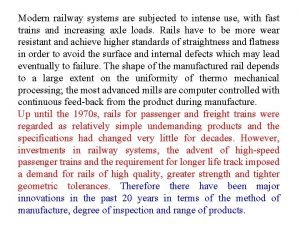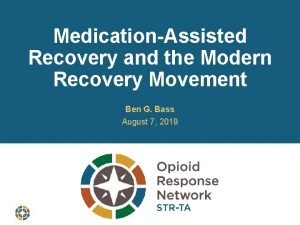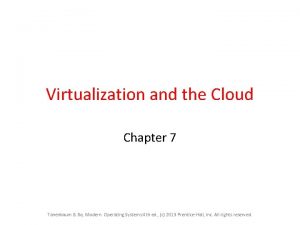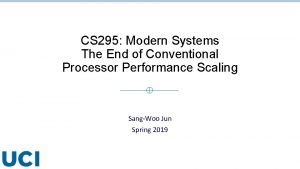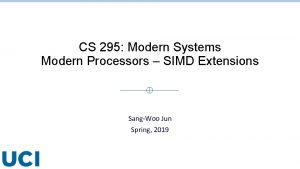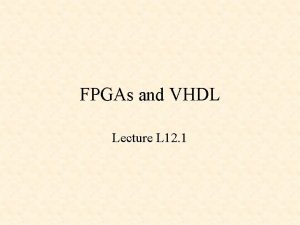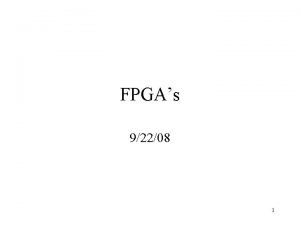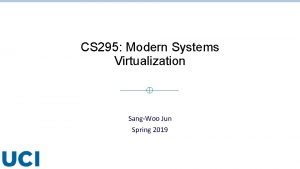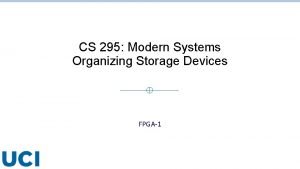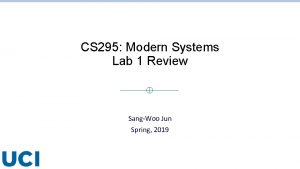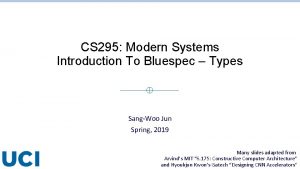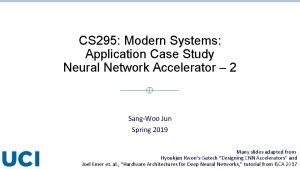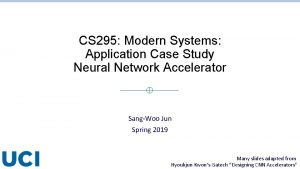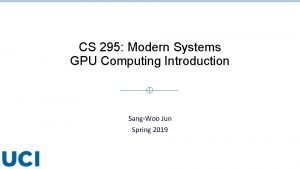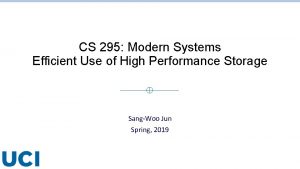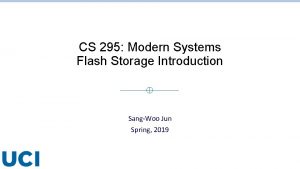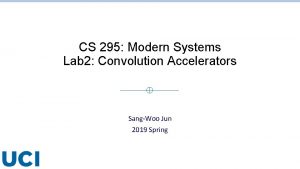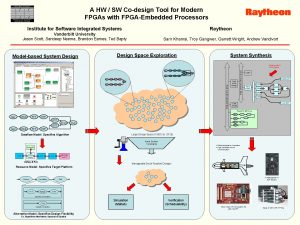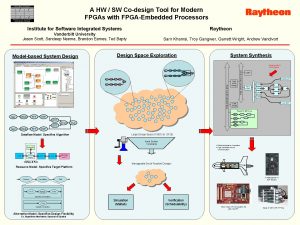CS 295 Modern Systems What Are FPGAs and






















- Slides: 22

CS 295: Modern Systems What Are FPGAs and Why Should You Care Sang-Woo Jun Spring, 2019

What Are FPGAs q Field-Programmable Gate Array q Can be configured to act like any circuit – More later! q Can do many things, but we focus on computation acceleration

FPGAs Come In Many Forms PCIe-Attached CPU Integrated In-Storage In-Network

How Is It Different From CPU/GPUs q GPU – The other major accelerator q CPU/GPU hardware is fixed o “General purpose” o we write programs (sequence of instructions) for them q FPGA hardware is not fixed o “Special purpose” o Hardware can be whatever we want o Will our hardware require/support software? Maybe! q Optimized hardware is very efficient o GPU-level performance** o 10 x power efficiency (300 W vs 30 W)

Analogy CPU/GPU comes with fixed circuits FPGA gives you a big bag of components To build whatever “The Z-Berry” “Experimental Investigations on Radiation Characteristics of IC Chips” benryves. com “Z 80 Computer” Shadi Soundation: Homebrew 4 bit CPU Could be a CPU/GPU!

Fine-Grained Parallelism of Special-Purpose Circuits q A = G × m 1 C = x 1 - x 2 E = y 1 - y 2 B = A × m 2 D = C 2 F = E 2 G = D + F Ret = B / G 4 cycles with basic operations A = G × m 1 × m 2 B = (x 1 - x 2)2 C = (y 1 - y 2)2 D = B + C Ret = B / G 3 cycles with compound operations May slow down clock Ret = (G × m 1 × m 2) / ((x 1 - x 2)2 + (y 1 - y 2)2) 1 cycle with even further compound operations

Coarse-Grained Parallelism of Special-Purpose Circuits q Typical unit of parallelism for general-purpose units are threads ~= cores q Special-purpose processing units can also be replicated for parallelism o Large, complex processing units: Few can fit in chip o Small, simple processing units: Many can fit in chip q Only generates hardware useful for the application o Instruction? Decoding? Cache? Coherence?

How Is It Different From ASICs q ASIC (Application-Specific Integrated Circuit) o Special chip purpose-built for an application o E. g. , ASIC bitcoin miner, Intel neural network accelerator o Function cannot be changed once expensively built q + FPGAs can be field-programmed o Function can be changed completely whenever o FPGA fabric emulates custom circuits q - Emulated circuits are not as efficient as bare-metal o ~10 x performance (larger circuits, faster clock) o ~10 x power efficiency

Basic FPGA Architecture “Configurable logic block (CLB)” Programmable ~ I/O block Latch 6 -Input Look-Up Table FF Ex) 2 -LUT for “AND” Input 1 Programmable interconnect Input 2 Output 0 0 1 1 1 Sequential circuit construction

Basic FPGA Architecture – DSP Blocks “DSP block” q CLBs act as gates – Many needed to implement high-level logic q Arithmetic operation provided as efficient ALU blocks o “Digital Signal Processing (DSP) blocks” o Each block provides an adder + multiplier × +/-

Basic FPGA Architecture – Block RAM “Block RAM” q CLB can act as flip-flops o (~1 bit/block) – tiny! q Some on-chip SRAM provided as blocks o ~18/36 Kbit/block, MBs per chip o Massively parallel access to data → multi. TB/s bandwidth

Basic FPGA Architecture – Hard Cores Memory Ethernet ARM PCIe q Some functions are provided as efficient, non-configurable “hard cores” o o o Multi-core ARM cores (“Zynq” series) Multi-Gigabit Transceivers PCIe/Ethernet PHY Memory controllers …

Example Accelerator Card Architecture q “FPGA Mezzanine Card” Expansion General-Purpose I/O Pins o Network Ports, Memory, Storage, PCIe, … Multi-Gigabit Transceivers FMC DRAM 1 Gb. E FPGA 40 Gb. E PCIe DRAM

Example Accelerator Card (VCU 108)

Programming FPGAs q Languages and tools overlap with ASIC/VLSI design q FPGAs for acceleration typically done with either o Hardware Description Languages (HDL): Register-Transfer Level (RTL) languages o High-Level Synthesis: Compiler translates software programming languages to RTL q RTL models a circuit using: o Registers (state), and o Combinational logic (computation)

Hardware Description Language q Software programming languages: Describes process q Hardware description languages: Describes structure std: : queue<float> input_queue; std: : queue<float> output_queue; float factor; Exists in memory while (true) { if ( !input_queue. empty() ) { ret = input_queue. front() * factor; output_queue. push(ret) input_queue. pop(); } } Instructions For CPU FIFO#(Float) input_queue <- mk. FIFO; FIFO#(Float) output_queue <- mk. FIFO; Reg#(Float) factor <- mk. Reg; Float. Mult. Ifc mult <- mk. Float. Mult; Exists on chip rule in; mult. enq(factor, input_queue. first); input_queue. deq; endrule out; ret <- mult. result; output_queue. enq(ret); endrule Creates circuits

Major Hardware Description Languages q Verilog: Most widely used in industry o Relatively low-level language supported by everyone q Chisel – Compiles to Verilog o Relatively high-level language from Berkeley o Embedded in the Scala programming language o Prominently used in RISC-V development (Rocket core, etc) q Bluespec – Compiles to Verilog o Relatively high-level language from MIT o Supports types, interfaces, etc o Also active RISC-V development (Piccolo, etc)

High-Level Synthesis q Compiler translates software programming languages to RTL q High-Level Synthesis compiler from Xilinx, Altera/Intel o o Compiles C/C++, annotated with #pragma’s into RTL Theory/history behind it is a complex can of worms we won’t go into Personal experience: needs to be HEAVILY annotated to get performance Anecdote: Naïve RISC-V in Vivado HLS achieves IPC of 0. 0002 [1], 0. 04 after optimizations [2] q Open. CL o Inherently parallel language more efficiently translated to hardware o Stable software interface [1] http: //msyksphinz. hatenablog. com/entry/2019/02/20/040000 [2] http: //msyksphinz. hatenablog. com/entry/2019/02/27/040000

FPGA Compilation Toolchain High-Level HDL Code Language Compiler Verilog/ VHDL High-level language vendor tool “Which transceiver instance should top_transceiver_01 map to? ” And so, so much more… Constraint File Functional Simulation Cycle-level Simulation FPGA Vendor toolchain (Few open source) Synthesize Netlist Map/ Place/ Route Bitfile

Programming/Using an FPGA Accelerator q Bitfile is programmed to FPGA over “JTAG” interface o Typically used over USB cable o Supports FPGA programming, limited debugging access, etc q PCIe-attached FPGA accelerator card is typically used similarly to GPUs o Program FPGA, execute software o Software copies data to FPGA board, notify FPGA -> FPGA logic performs computations -> Software copies data back from FPGA q FPGA flexibility gives immense freedom of usage patterns o Streaming, coherent memory, …

Partial Reconfiguration FPGA Sub-components q Parts of the FPGA can be swapped out dynamically without turning off FPGA o Physical area is drawn on chip q Used in Amazon F 1, etc q Toolchain support for isolation

FPGAs In The Cloud q Amazon EC 2 F 1 instance (1 – 4 FPGAs) q Microsoft Azure, etc…
 Antigentest åre
Antigentest åre Pages 294 and 295
Pages 294 and 295 Embedded microprocessor system design using fpgas
Embedded microprocessor system design using fpgas 7 series fpgas clocking resources user guide
7 series fpgas clocking resources user guide Basic fpga architecture
Basic fpga architecture Como estimar resultados de divisiones
Como estimar resultados de divisiones L
L Decreto 295
Decreto 295 Round 493 295 to the nearest ten thousand
Round 493 295 to the nearest ten thousand Topic 1 lesson 1-4
Topic 1 lesson 1-4 Komax gamma 333
Komax gamma 333 Kj no 295
Kj no 295 Modern systems analysis and design
Modern systems analysis and design Modern system analysis and design
Modern system analysis and design A modern approach to systems analysis and design
A modern approach to systems analysis and design Modern systems analysis and design 7th edition
Modern systems analysis and design 7th edition Modern railway systems
Modern railway systems Andrew tanenbaum modern operating systems
Andrew tanenbaum modern operating systems Modern med recovery
Modern med recovery Layers of operating system
Layers of operating system Modern operating systems 3rd edition
Modern operating systems 3rd edition Modern operating systems tanenbaum 5th edition
Modern operating systems tanenbaum 5th edition Deus ex on modern systems
Deus ex on modern systems


